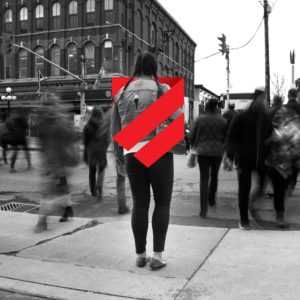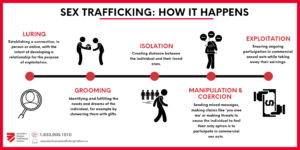When it comes to human trafficking, finding pictures online that accurately represent the reality faced by victims and survivors, while also being trauma-informed and victim-centered, can be a bit of a challenge. Today’s post debunks common myths conveyed through the use of popular images, presents readers with critical questions they can ask themselves before selecting an image, and provides alternative imagery options.
A simple Google search for images of ‘human trafficking’ reveals pictures featuring young girls, often locked up, in ropes or chains, without the ability to speak. These images can be found on posters, in awareness campaigns and in news stories that portray human trafficking. The unfortunate reality is that, more often than not, imagery in campaigns and news articles intended to combat human trafficking and raise awareness of the crime differs from the lived experiences of victims and survivors. As imagery is the most efficient way to quickly share information, it is not surprising that these highly publicized images have become intertwined with actual narratives of trafficking experiences. These misconceptions have the potential to shape community and individual responses to this crime; they may negatively affect how someone being trafficked views their own experience, and it affects the ability of community members to prevent trafficking, identify victims, and understand different narratives.
*While this blog post focuses primarily on sex trafficking imagery, it is important when discussing human trafficking to reference the prevalence of both sex and labour trafficking in Canada. For more information on labour trafficking, click here. We have also included alternative examples imagery that portray both sex and labour trafficking at the end of this post.
Image: A victim’s hands bound, with another hand or an object such as tape covering their mouth, or a barcode tattooed on their body
Image: Dark, unkempt rooms with little to no light
Image: Child, most often a young girl, often Caucasian
Image: A woman appearing to be selling sex on the street
CONCLUSION
There are always exceptions to these myths and facts; no two people’s experience with trafficking is the same. It is certainly possible that the experiences of a victim or a survivor may fit the imagery we have discussed and labeled above as problematic. However, this is not the norm. If the goal of human trafficking campaigns and articles using such imagery is to encourage disclosure and detection, and prevent further victimization, it is important that writers, journalists, and advocates make a shift in the imagery they use in order to be accurate and relevant to the majority of lived experience. This involves resisting oversimplified narratives, so that we may accurately depict the complexity of this crime Canada.
Only looking for physical signs of human trafficking such as the ones mentioned in the above myths ultimately does a disservice to victims and survivors, as it allows traffickers and their victims to move through our communities un-noticed. These symbols can also amplify the stigma faced by victims and survivors of trafficking whose experiences don’t align with being kidnapped, taken, or physically trapped. That’s why, it is important to consider using images representing people in everyday situations, such as an individual taking the subway, text messaging, or walking down the street, and ensure the images are reflective of the diversity that exists in our communities. Below, we have included examples of images which could be referenced as part of future articles and campaigns.
- Canadian Human Trafficking Hotline Images (downloadable here)





